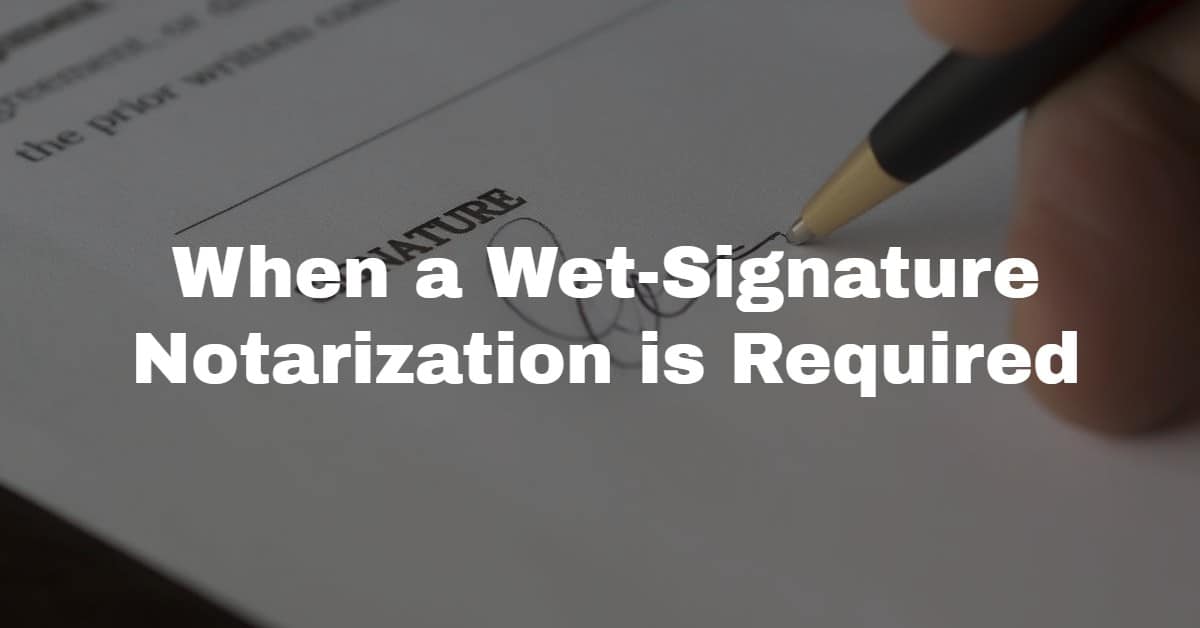The outbreak of COVID-19 has impacted how we conduct our daily lives on a global scale, both in our personal and work lives. Various hurdles now surround once common tasks involved in a business or legal transaction.
Many legal documents must be executed in the presence of a notary, which is easier said than done with stay-at-home orders in place. It is important that certain transactions, such as buying real estate or preparing your will move forward as much as possible, while keeping our safety and the safety of others in mind.
Senate Bill 704 was recently passed in North Carolina in an effort to mitigate some of the damage the pandemic has caused in regards to the continuance of business and legal transactions. Pursuant to this bill, all North Carolina Notary Publics may temporarily perform emergency video notarizations until August 1, 2020, so that transactions requiring a notary will not hinder or delay crucial business transactions, real estate transactions, medical documents, court documents, and most other transactions requiring a notary, with some exclusions.
What does this mean and how does it change things? Excluding election documents, any document requiring a notary can be done over video conference technology. Below we will explore some of the requirements and guidance on how an emergency video notarization can take place and address some frequently asked questions.
Location and Technology
First of all, the notary public and each principal signor must be physically located in North Carolina at the time of the video and the record’s signing. The signor must state that they are located in North Carolina and the county in which they are executing the document.
Both the personal performing the notarial act and the principal signor both must appear in real-time, meaning that no pre-recorded video or audio is allowed.
Clear and continuous audio and visual technology should be maintained throughout the entire video notarization process to allow all participants to hear, see, and understand each other at all times of the video.
Identification
If the signor is personally known to the person performing the notarial act, identification is not required. If the signor is not personally known by the notary, he or she must provide and display an acceptable form of identification to the notary over the video. The notary must be able to verify this on the live-video conference.
A satisfactory identification must include at least one document that meets all of the following criteria:
a. It is current or not expired prior to March 10, 2020;
b. Issued by a state, federal or recognized tribal government agency;
c. Has a picture of the principal’s face.
d. Has a physical description and signature of the principal.
Notarial Act
The notary must observe each principal signor sign each document to be notarized. If there are multiple signors in one transaction, both must be clearly seen and heard. The signor must state which document is being signed as they do so. This is especially important if multiple documents are being signed, like when you purchase a house.
Some documents require an oath or affirmation. If so, the notary must administer the oath or affirmation to the affiant which must be in life, real-time video technology.

Depending on the type of document, an original wet-signed notarization may be required. It is important determine whether an original is required prior to emergency video notarization takes place to avoid future complications.
You should do your research on what is required prior to the live-video notarization to ensure proper protocols are adhered to. If an original wet-signature notarization is necessary, the following should take place:
• Principal Signor: After the live-video meeting has taken place between the notary public and the principal signor, the principal signor must transmit a clear and legible copy of the signed document to the notary on the same day that the document was signed. This can be accomplished by fax, email, or other reliable electronic delivery methods. In addition to submitting an electronic copy of the document to the notary, the principal signor must deliver the original, signed document to the notary. This can be done by personal delivery, mail, or other means.
• Notary Public: Upon receipt of the physical record, the notary must compare the original document to the electronic copy to determine that they are the same. Upon approval, the notary must notarize the wet-signature on the original document and date it with the date that the video notarization took place, even if the physical original is received on a later date. The document with both the principal and the notary’s original signature should be transmitted back to the principal or person designated to receive the document by mail, physical delivery or other means.
When a Wet-Signature Notarization is Not Required
If you have determined that a wet-signature notarization is not required, certain rules still apply. The principal signor or their designee shall send an electronic copy of the signed document to the notary by fax, email, or other electronic technology.
Again, this must happen the same day that the video notarization took place. Upon receipt, the Notary should print the document and perform the notarization. Once complete, they should transmit the document back to the principal signor or their designee on the same day.
As you can see, whether or not an original wet-signed notarization is required, both procedures require quick action and attention to detail on both the part of the principal signor and the notary public.
The new laws surrounding emergency video notarization does not change or affect any originality verification requirements for recording with Registers of Deeds, Clerks of Superior Court, or other government or private office in this State.
Notary Journal
The Notary should always record the details of their notarization in their notary journal. Unfortunately, this step is often ignored. If you are a notary, please remember that this step is required, and is particularly critical for video notarizations.
The journal must be kept by the notary for at least 10 years and kept in a secure location. Electronic journals are allowed, which may be easier to maintain than a physical journal depending on personal preference. Some folks feel it is safer to keep an actual journal that they can physically hold and carry with them. Other people prefer the efficiency of an electronic journal.
No matter which option you decide, make sure to record the correct information and store it in a safe place. The notary should include the following information in their journal for each video notarization:
• Description of the video conferencing technology utilized to perform the emergency video notarization, such as Zoom, Skype, or otherwise. Details of the sound and visual quality should be noted.
• Full legal name of the principal signor(s). If other persons were present in the room with the signor, record the name of that person.
• Type of identification presented by the signor and accepted by the notary. If not personally known to the notary, the details of why the identification was satisfactory should be noted.
• Title or type of document being notarized and type of notarial act and/or performed proceeding.
• Date and time of observation of the principal’s identification and signing of each document presented and signed by each principal signor. Personally, I find screen shots helpful to ensure accurate records are maintained.
• Date of the completion of the notarial certificate.
• Anything else that the Notary may think is relevant or important for record-keeping and memory-related purposes.
Notarial Certificate
A typical notary certificate includes certain standard information, such as the state and county where the notarial act is being performed, the name of the principal signor, an oath or affirmation, the name of the notary and their signature, the date the notary’s commission expires, and of course, the notary seal.
Emergency video notary certificates must also include the following language:
1. I signed this notarial certificate on ______(Date) according to the emergency video notarization requirements contained in G.S. 10B-25.
2. The North Carolina county in which the Notary Public was located during the emergency video notarization.
3. The North Carolina county in which the principal signer(s) stated they were physically located during the emergency video notarization.
The person preparing the notary certificate should find out if the notarial act will be performed via video technology and if so, include this language in the certificate.
A notary should remember that they may refuse to perform a notarial act if they are not satisfied that the required criteria has been met. If this happens, remember to note the details surrounding the situation in your notary journal in case questions arise in the future. As a trusted public official, a notary must also maintain confidentiality.
Emergency Video Witnessing
Many legal documents require the signature of a witness or witnesses, sometimes in addition to notarization. Those acting as a video witness under this law must still be located in North Carolina. Unless otherwise excluded by law, a person witnessing the signature of a document via video technology shall be considered an “in-person” witness.
The document shall be considered to have been signed in the presence of such witness, if the technology being used allows for real-time audio and visual interaction between the signor and the witness.
The signature of the principal signor must be visually witnessed by the attesting witness.
As soon as the principal signor signs the document, the witness should immediately thereafter sign the document while the video technology still allows for real-time audio and visual interaction.
Documentation that is witnessed by emergency video witnessing must contain the following:
1. A conspicuous statement acknowledging that the document was witnessed by one or more witnesses physically located in the State of North Carolina pursuant to N.C.G.S. § 10B-201.
2. The county in which each remote witness was physically located during their witnessing of the execution of the record.
3. The county in which each principal signor was physically located during the witnessed execution of the record.
Unless otherwise excluded by law, any record witnessed by video may be signed in counterpart (separately). When combined, those separate documents shall create a single, original record.
Logistically, video witnessing has potential to be confusing so it is important for the principal and witness to make clear and concise plans prior to the actual video signing.
A simple misunderstanding can cause a variety of problems in the future. The document should be sent to the witness(es) in advance of the actual video signing and printed.
During the video signing, the witness and the principal signor should clearly state that they understand that they are signing the same document (especially important if there are previous versions or last-minute changes). The witness should submit the record they signed to the principal signor or their designee.
If a document requires notarization and witnessing, the notary public, principal signor and witness should communicate before, during, and after the video conference to ensure the new guidelines are maintained.
Ultimately, the new legislation on video notarizations and witnessing will help move us along until our world settles into its new “normal.” It is reasonable to expect additional changes or requirements after August 1, 2020, so remember to be aware of future developments.
The Secretary of State’s office an provide further information about the new requirements. For legal advice, we recommend contacting an attorney licensed in North Carolina.


